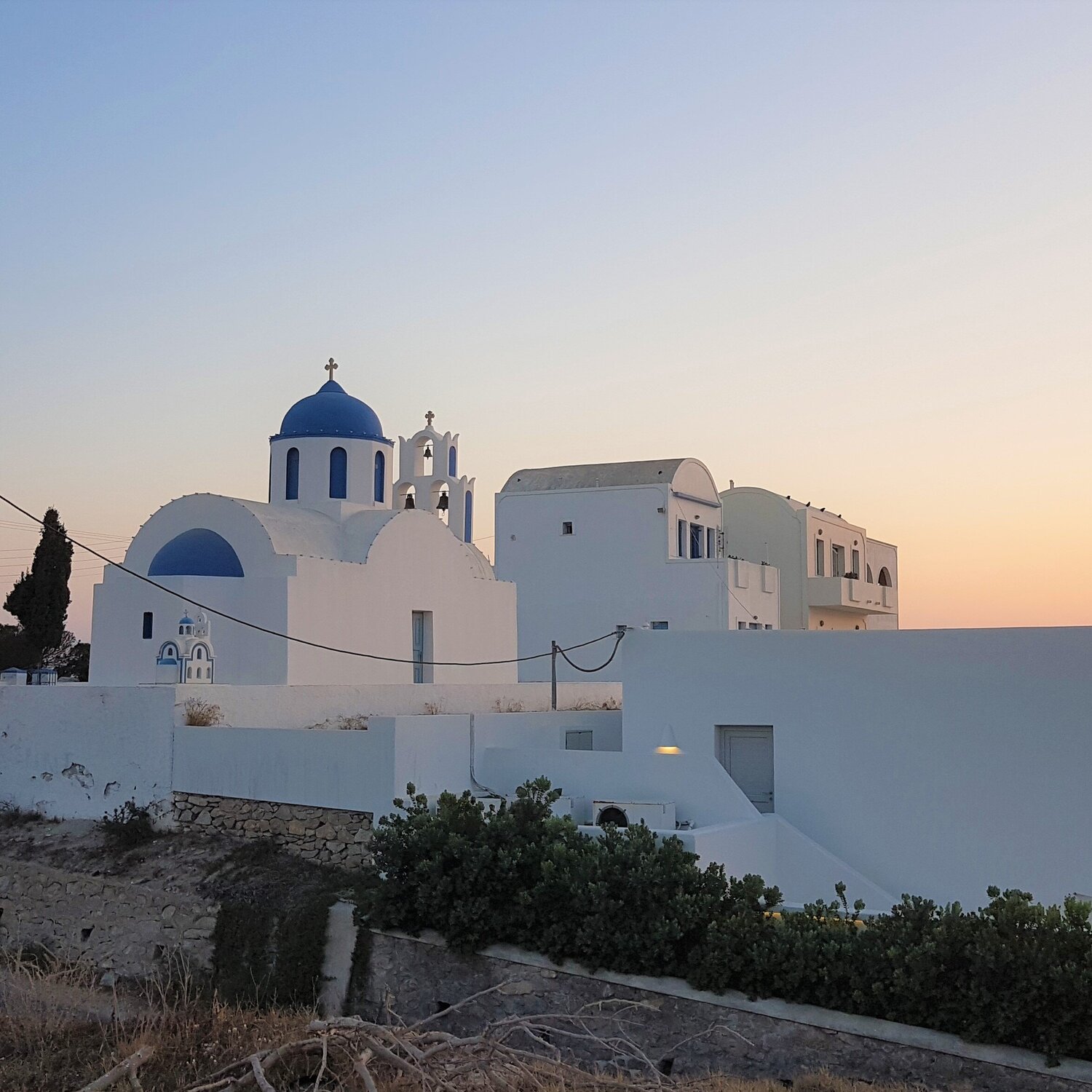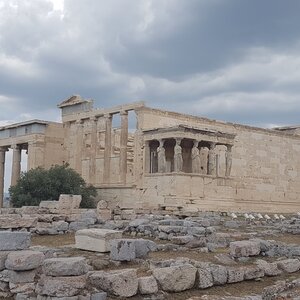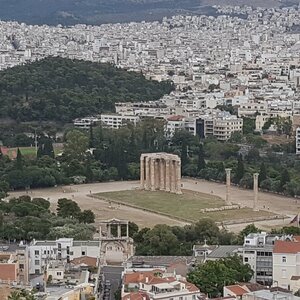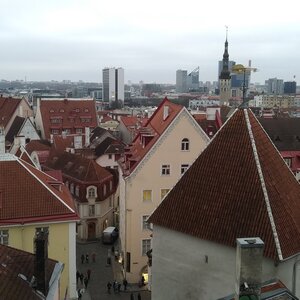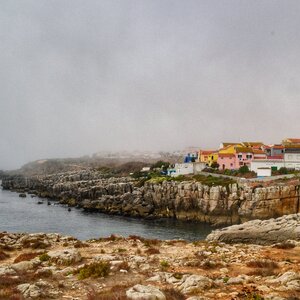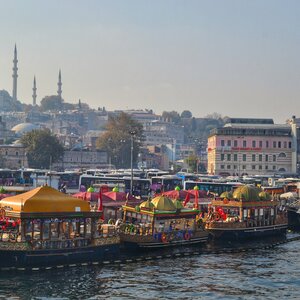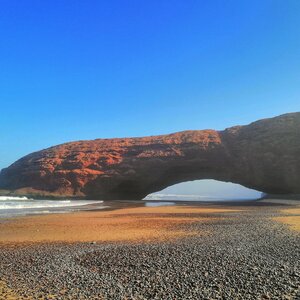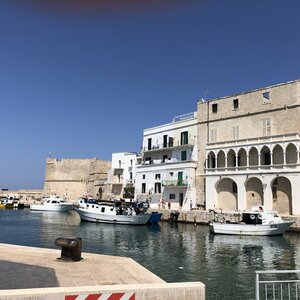Santorini is actually a group of islands, the largest of which, Thirou, is often called Santorini. It is believed that once it was one island with a high active volcano, but as a result of an eruption it was divided into several parts, and in place of the mountain formed a basin several hundred meters deep, which was flooded by the sea — this is the famous Caldera. Historians say that this is how the myth of the sunken Atlantis appeared.
Now Tira, together with the islands of Tirasia (Θηρασία), Palea-Kameni (Παλαιά Καμένη), Nea-Kameni (Νέα Καμένη) and Aspronisi (Ασπρονήσι) form a figure resembling a ring from the air.
I’ll tell you how to spend a week in Santorini to cover as much as possible and get into the atmosphere of this amazing place. How to choose the best resort for your vacation — read here.
Fira (Θήρα)
Fira, or Tira, is the capital of the island. It is a very small town, but it is where the main life is concentrated, as in any capital city. There are no beautiful, comfortable beaches, but there are plenty of stores, souvenir stores, cafes and nightclubs. It is worth coming here more than once: in the daytime to visit museums, admire the caldera, buy souvenirs, go on excursions and have lunch in a cozy restaurant, and in the evening you are waiting for numerous nightclubs and bars. Entrance to them, as a rule, is free, so in one evening you can go around several places at once.
The two most interesting museums in Fira, the Arechological Museum and the Prehistoric Museum, are the place to go in search of historical heritage. The two most interesting museums in Fira are the Arechological Museum and the Prehistoric Museum.
Both museums are open daily, except Tuesdays, from 8:30 a.m. to 3:30 p.m. in November through March and until 4 p.m. in the summer.
Admission is inexpensive year-round, and several times a year both museums are free: March 6, April 18, May 18, and the last weekend in September.
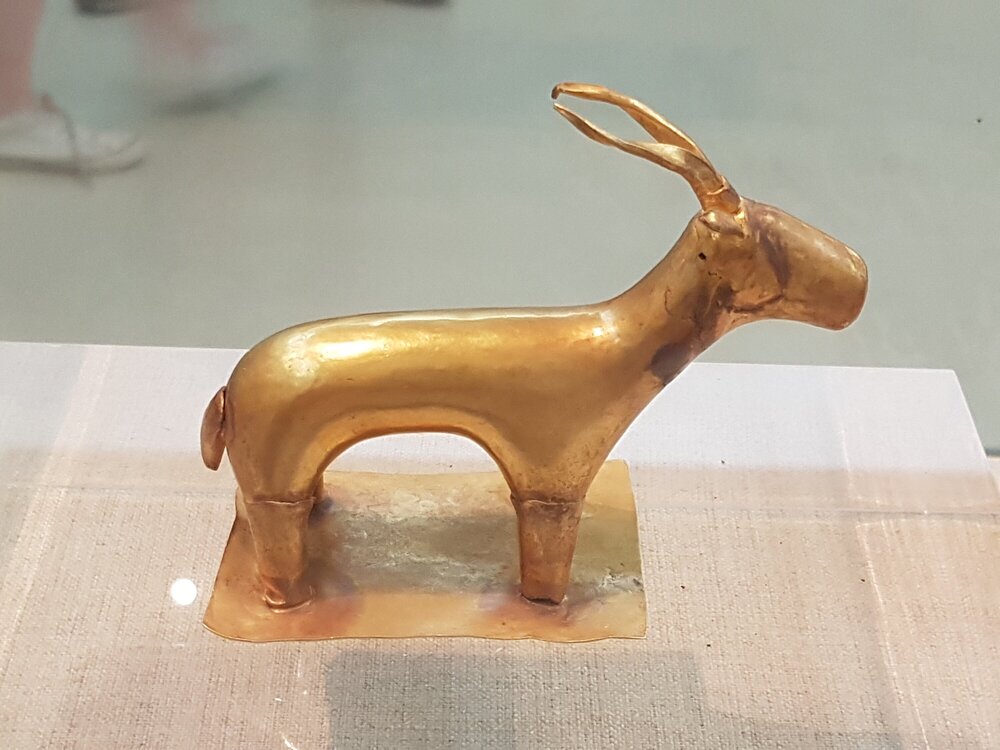
Prehistoric Museum
For the most part, it contains artifacts found during excavations at Akrotiri (Ακρωτήρι). The most notable exhibits include a golden figure of a goat, a marble statuette, several jugs, a Minoan vase, a mold of a wooden table and a clay oven.
Archaeological Museum
A small but very interesting museum whose exhibits were mainly found in Ancient Tyre and Akrotiri. It is a collection of vases, sculptures, statuettes, frescoes and much more.
Where to eat in Fira
- Family restaurant Salt & Pepper — suitable for lovers of Greek cuisine
- Falafeland is a great fast food joint
- Why not! Souvlaki — Greek cuisine and fast food in one bottle.
Archaeological excavations of Akrotiri (Ακρωτήρι)
Akrotiri is a small village on Santorini and the ancient settlement of the same name, which was destroyed by a volcanic eruption around 1500 BC. It is believed to have been an advanced city belonging to the Minoan civilization. An interesting fact is that no human remains were found during the excavations. Historians explain this by the fact that, perhaps, the local inhabitants had time to leave the island before the eruption, or they are resting in deeper layers, to which archaeologists have not yet reached, because to date have managed to free from the ash only about 35% of the area.
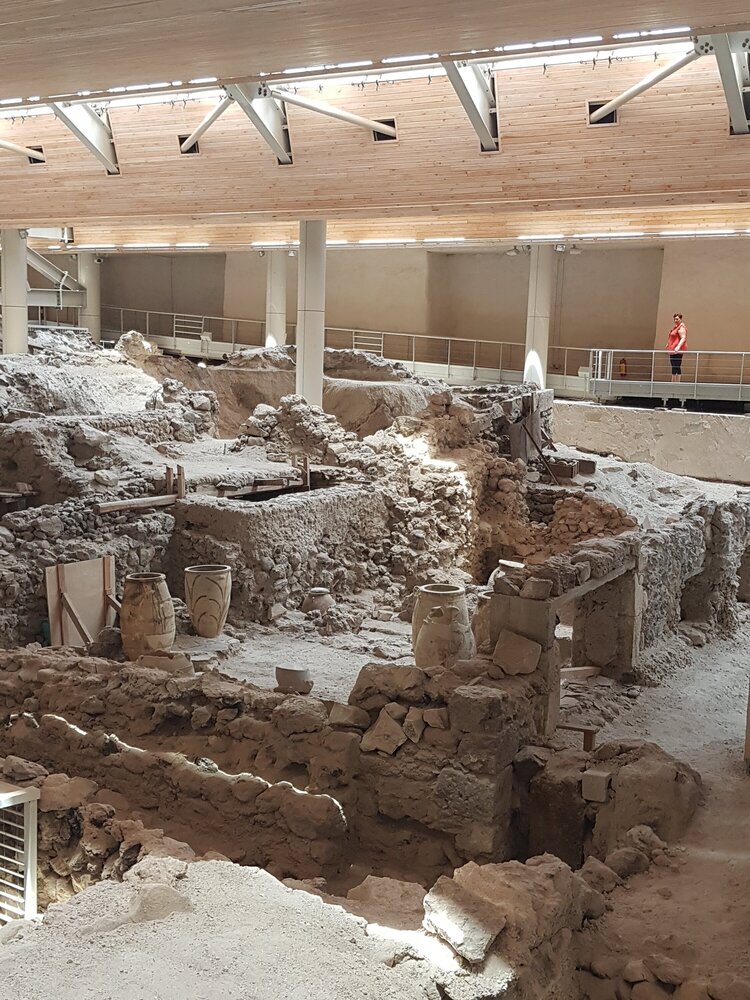
The excavation area makes a lasting impression. There are pavilions with special paths over them, along which you can walk around the entire area and examine the foundations of buildings, some of which had three floors, various artifacts, clay vessels and frescoes. Here you will see the houses of commoners, artisans and rich citizens of the ancient city.
Hours are daily except Tuesday, 8:30 a.m. to 3:30 p.m. November through March, until 6:30 p.m. April through September, and on a floating basis in October. Check the schedule on the website.
You can get to Akrotiri by bus from Fira bus station. The ticket price is 1,8 € to Akrotiri village and 2 € to the excavations. Buses leave at intervals of 30 — 60 minutes. The travel time is 20 minutes.
Ancient Tyre (Αρχαία Θήρα)
This place is worth visiting even if you are not a fan of archaeological excavations. Ancient Thira is located on a high mountain and from here you can enjoy a magical view of the island and the endless expanse of the Aegean Sea. You can sit here for hours and watch airplanes landing and taking off below, boats and yachts passing by, while here, on the top of the mountain, time seems to have stopped.
Ancient Tyre was once not just a city, but a polis — a city-state. Its territory is quite compact: only 800 meters long and 150 meters wide. Nevertheless, there is the Agora — market square, temples, and ancient theater, and baths, and residential areas. The inhabitants of the city were engaged in agriculture, animal husbandry and seafaring, and traded with Crete, Athens and Rhodes.
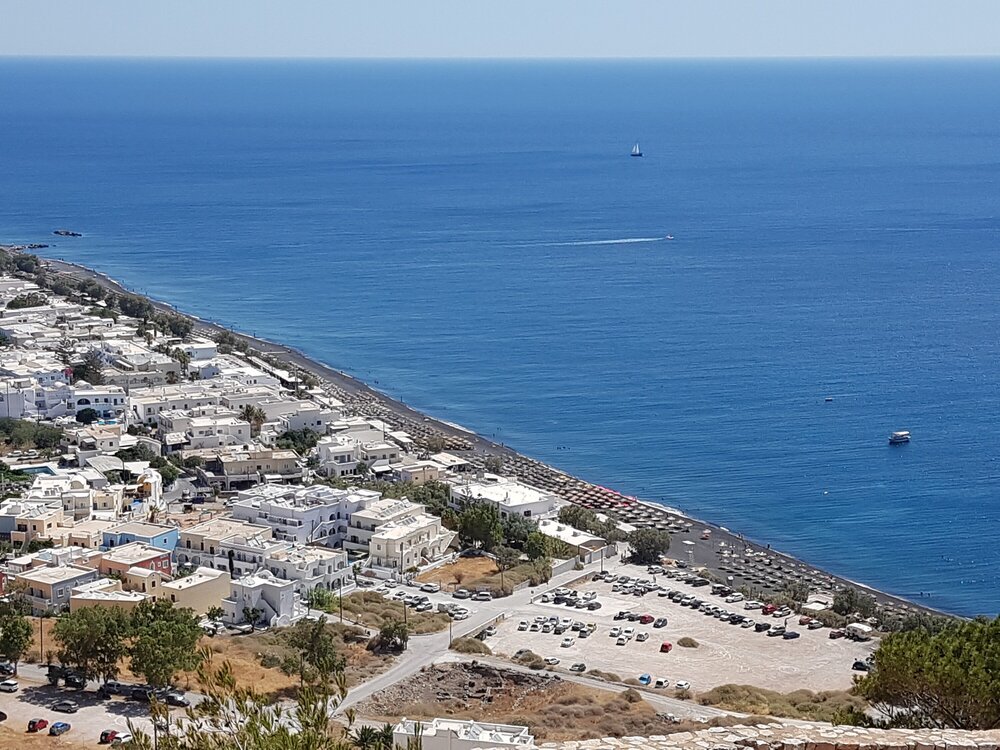
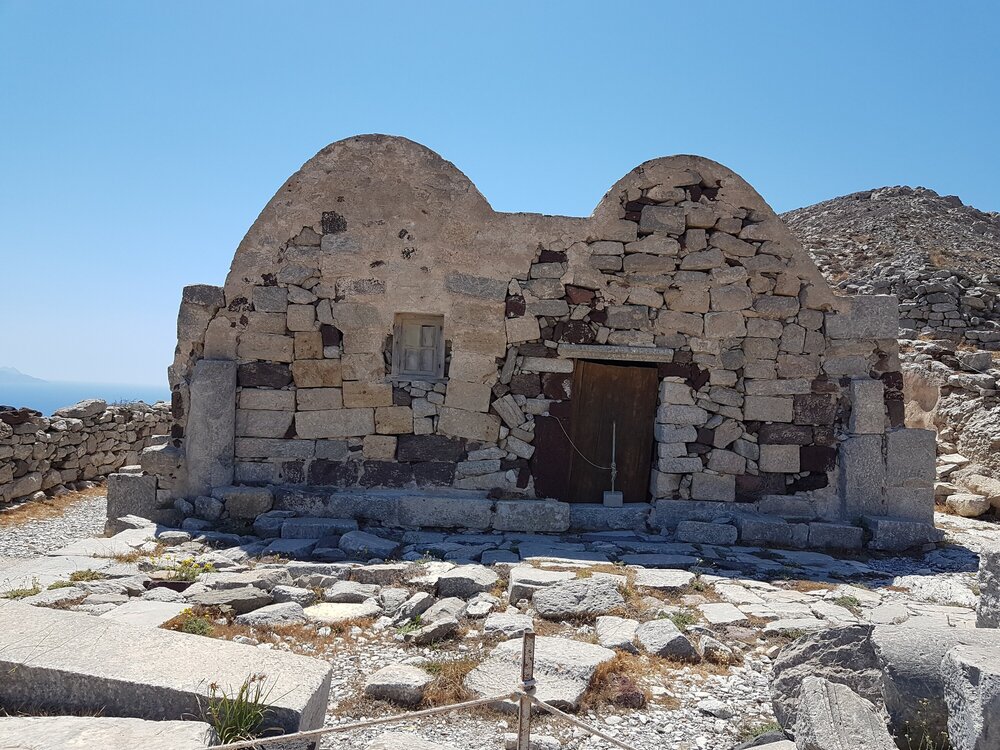
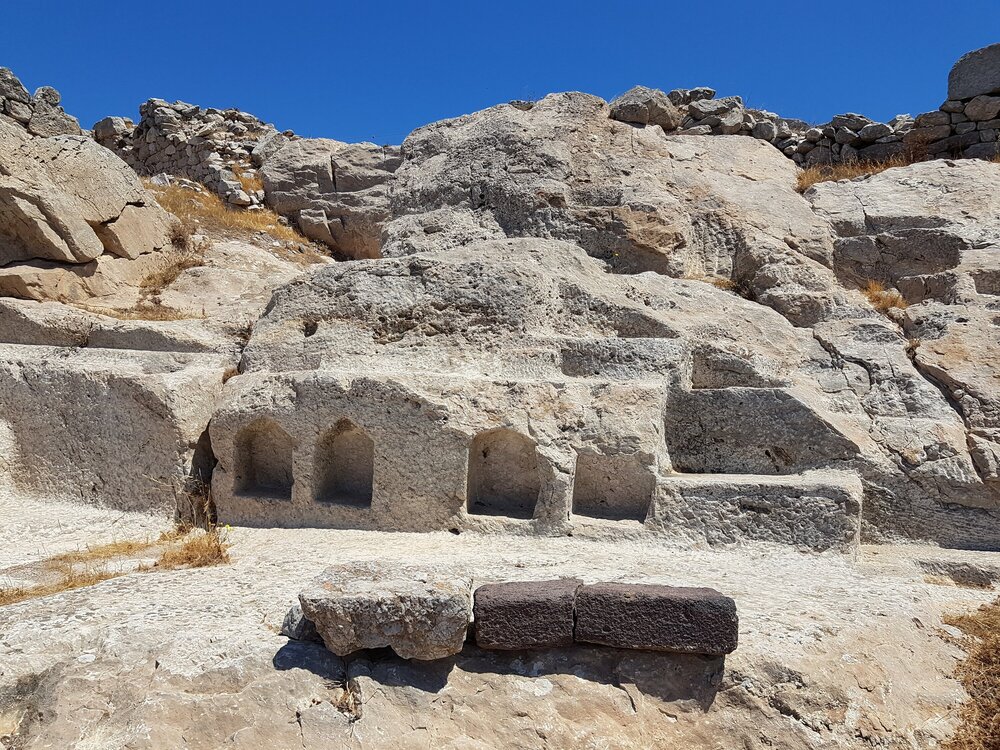

There are many ways to get to Ancient Thira, even on foot — there is a trail from Perissa (Περίσσα) that takes just over an hour. The second way is to take the tourist bus to Kamari (Καμάρι). For this you will have to contact any local travel agency. There is no public transportation directly to Ancient Thira.
Open daily, except Tuesdays, from 8:30 a.m. to 3:30 p.m. in the winter, until 4 p.m. in the summer.
Boat trips around Caldera and the islands
A trip to Santorini is definitely not complete without it. Very interesting:
- See the famous white houses with blue roofs from a new angle.
- Wander around the volcano, the island of Nea Kameni, which is a pile of lava and rocks. You can find places where hot steam comes out of the ground, because the volcano is active.
- Swim in the hot springs — they are located near the island of Palea Kameni. You can’t go to the island itself, you have to go down or dive into the water from the ship. The water there is really warm, but not very clean, so it is not recommended to wear light-colored swimsuits.
- Visit the only inhabited island of Thirasia, apart from Santorini itself. There is a small village here — you can wander around it and have a bite to eat in a local restaurant.

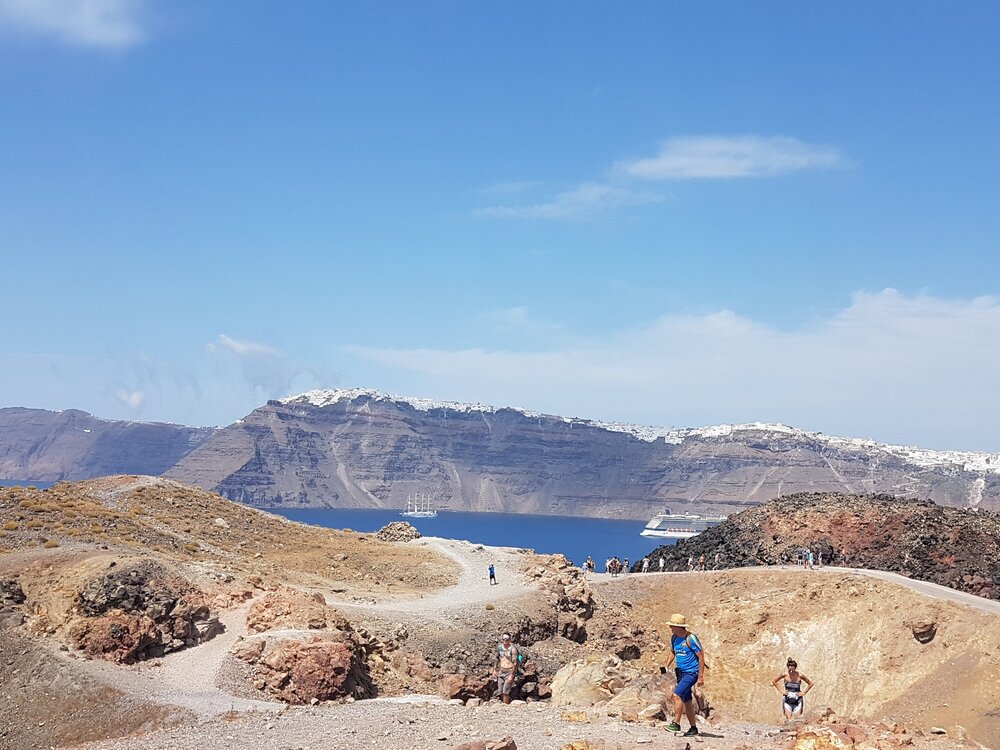

Travel agencies offer different options for excursions. The most popular ones are:
- Only the volcano tour — 18 €
- Excursion to the volcano and hot springs — 20 €. The trip takes 3 hours.
- Excursion to the volcano, hot springs and the island of Tirasia — 28 € for a 6-hour trip and 39 € for an 8-hour trip.
- Excursion to the volcano and hot springs, sunset meeting on the ship with a glass of local wine — 39 €.
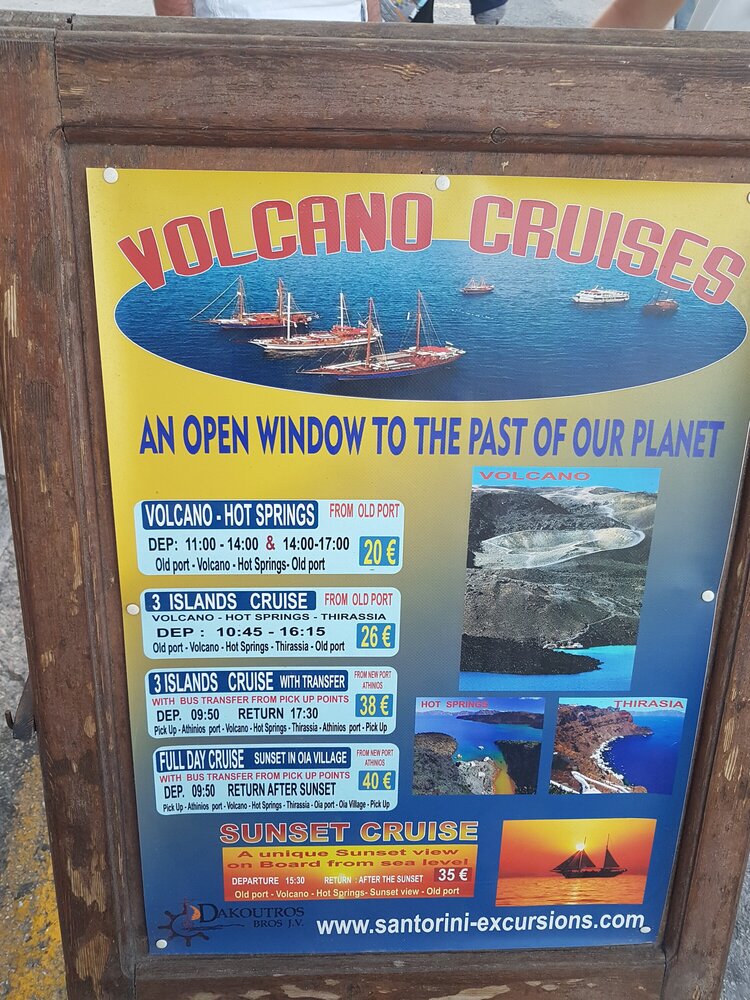
Tourist boats leave from the Old Port and you have to get there on your own. There are three ways to get there:
- Walk down — the journey takes about half an hour down the steps.
- Riding a donkey up the same steps. Price 5 €.
- Take the funicular. The price is 6 €. The trip takes literally 5 minutes.
Wineries and wine museum
The island of Santorini is famous for its wines — they are special, you won’t find them anywhere else. This is due to the local climate — grapes have to survive in rather harsh conditions. The volcanic soil changes the taste of wine: even those varieties that grow on the mainland sound completely different on the island.
There are quite a few wineries on the island where you can taste and buy wine. A visit to a winery can be combined with a tour of the small villages of Santorini with a tasting of local wine (from 70 €).
The Koutsoyiannopoulos family has organized an entire underground museum where you can learn about the history of viticulture in Santorini, study all stages of the winemaking process, and see rare equipment and winemaking tools.
The museum is located in a cave 8 meters underground and is shaped like a labyrinth — it took 21 years of hard work to build. The tour is conducted in 14 languages (including Russian) with an automatic audio guide.
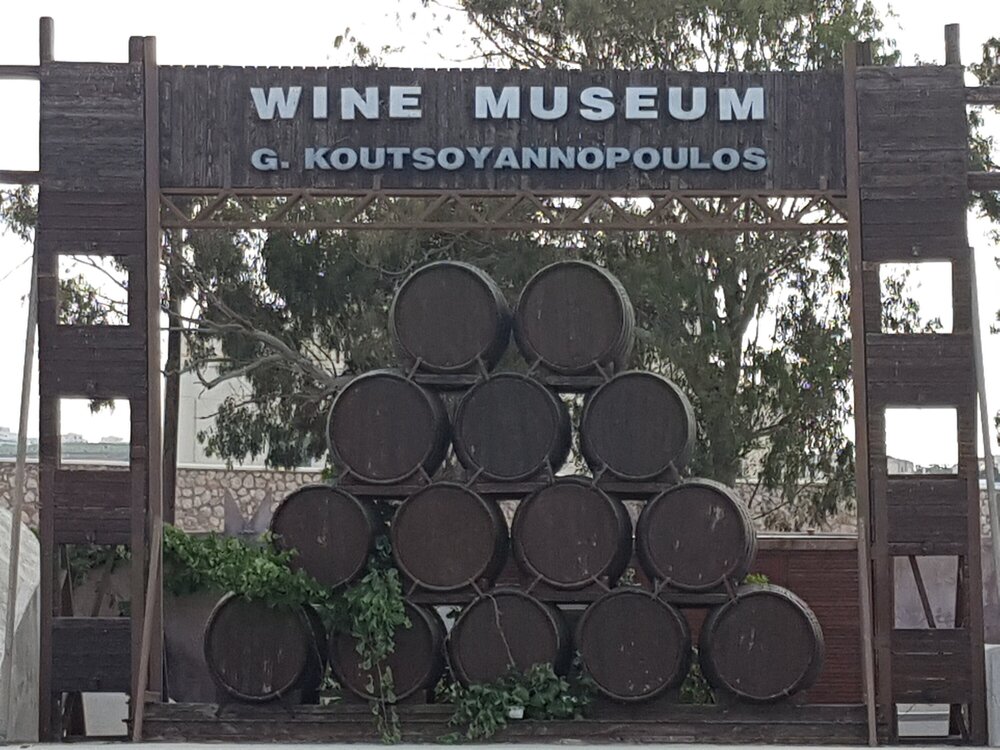
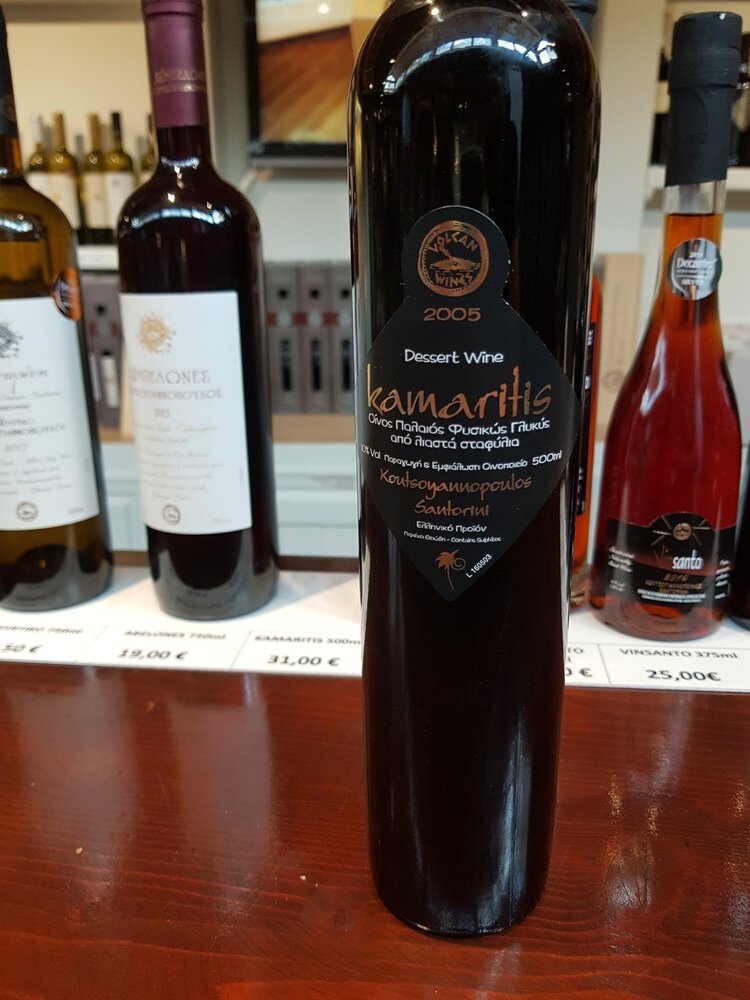
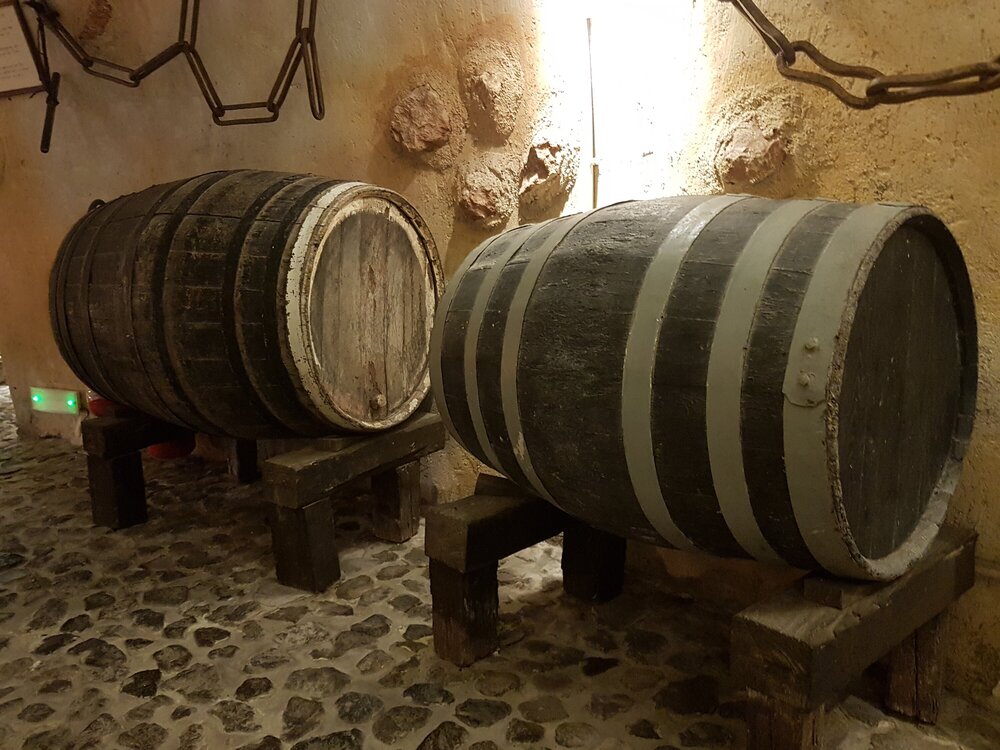
The museum is open weekends, 9:00 a.m. to 5:00 p.m. November through March 9:00 a.m. to 7:00 p.m. April through October. On Sundays the museum opens at 10:00.
The entrance fee includes a small wine tasting. And for 60 € you can book a tour of several wineries in Santorini, including Koutsoyannopoulos, and compare their wines with each other.
The museum can be reached by bus from Fira to Kamari. Get off at the Koutsoyannopoulos stop. The journey will take 10—15 minutes.
Open-air movie theater
My personal recommendation is to go to the open air movie theater in Kamari. In the evenings they show movies in English with Greek subtitles — a great way to diversify your vacation. Movies start at 21:30, but it is better to arrive in advance — tickets are sold only on the spot, and there are a lot of people in high season. Right in the hall there is a cozy bar, where you can buy drinks and popcorn at any time. In the middle of the film, as in a theater, there is an intermission.
Oia.
Ia (Oia) is a small town in the northern part of Santorini. Due to the magnificent view of the caldera of the extinct volcano and the fact that the coast is oriented strictly to the west, crowds of tourists flock here every evening to see one of the most romantic sunsets in the world. It is here that they take pictures of «those» blue roofs against the backdrop of snow-white walls and the endless sea.
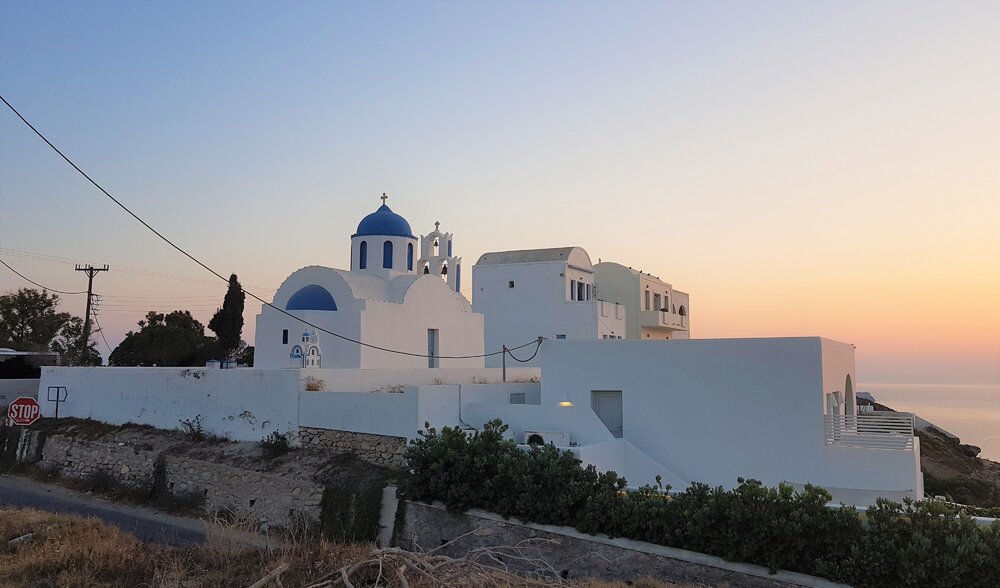
Like before a performance in a theater, people arrive early, take the best seats and watch as the sun slowly sets into the sea. Numerous restaurants and cafes offer to combine watching the sunset with a delicious dinner or at least a glass of local wine, which I definitely recommend trying.
The reviews are contradictory: some people think sunsets in Ia are the most beautiful in the world, while others think it’s a waste of time. This is the case when it is better to see once than to hear a hundred times. For me, it’s a very atmospheric place. And when all the tourists, after waiting for the sun to sink into the sea, noisily applaud, here you feel involved in something magical and great.

What else is there to see in Ia:
- The ruins of a Venetian fortress;
- Naval Museum;
- The old mill, the symbol of the town
- Fort Londza.
Buses to Ia depart from the bus station in Fira every 20—25 minutes. Travel time is about 20 minutes. The fare is 1.8 €.
What to bring back from Santorini
- Jewelry — silver bracelets, earrings, pendants encrusted with blue stones, looking like white houses with blue roofs.
- Leather goods — bags, belts, shoes tourists take home from all over Greece, and in Santorini the choice is quite large.
- Greek cosmetics — based on Greek olive oil.
- Local wines are white dry Assyrtiko and Nykteri, red dry Mavrotragano and dessert Vinsanto.
- Products made from volcanic lava — souvenirs, jewelry and even cosmetics containing lava and its minerals.
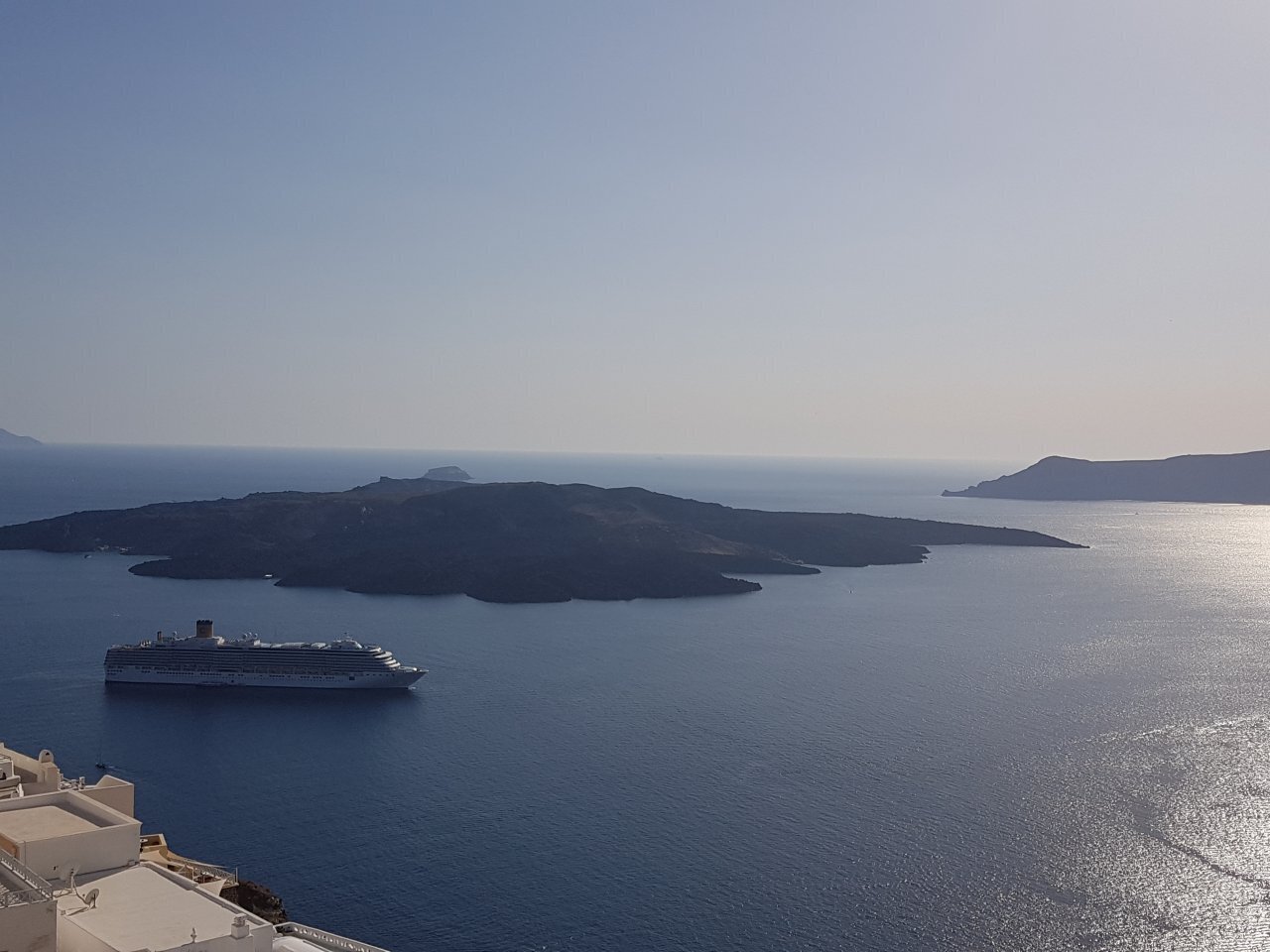
Useful information for preparing a trip to Santorini
- The official tourist site of the island, there is a Russian-language version.
- Greece’s official tourist site, section about Santorini.
- All of Santorini’s state museums are free of charge several days a year: March 6, April 18, May 18, and the last weekend of September. Akrotiri and Ancient Thira can also be seen for free on October 28 and every first Sunday of every month from November through March. Check the free days on each museum’s websites before traveling.
- A combination ticket for 14 € allows you to visit Akrotiri, Ancient Thira, the museums of Fira (Prehistoric History and Archaeological) and the Church Museum of Pyrgos. This ticket is valid for 4 days.
- You won’t need heels on a trip, except for a photo shoot. But from March to October, comfortable sneakers, a hat and sunscreen will be useful.
Santorini beckons hundreds of tourists from all over the world — it has been repeatedly recognized as one of the most beautiful places on Earth. Legends and myths about the island and the mysterious caldera still appear. And maybe in one of the excursions with diving between the islands you will find confirmation of it?

